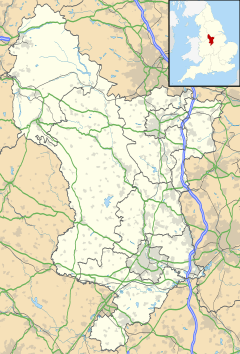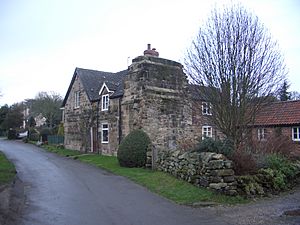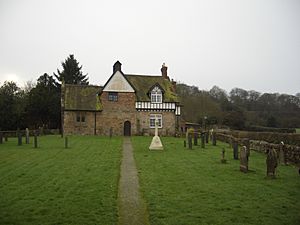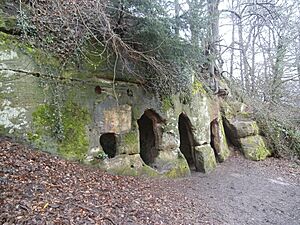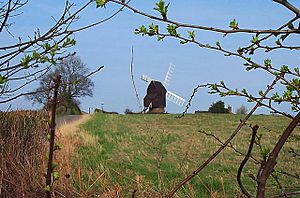Dale Abbey facts for kids
Quick facts for kids Dale Abbey |
|
|---|---|
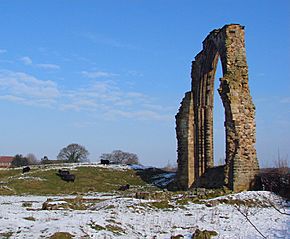 The ruins of the Abbey |
|
| Population | 1,351 (2011) |
| OS grid reference | SK 436 388 |
| District |
|
| Shire county | |
| Region | |
| Country | England |
| Sovereign state | United Kingdom |
| Post town | ILKESTON |
| Postcode district | DE7 |
| Police | Derbyshire |
| Fire | Derbyshire |
| Ambulance | East Midlands |
| EU Parliament | East Midlands |
| UK Parliament |
|
Dale Abbey is a small village in Derbyshire, England. It's about 6 miles northeast of Derby. In 2011, about 1,351 people lived here. The village used to be called Depedale or Deepdale. It is famous for the old ruins of an abbey that was built a long, long time ago, in the 12th or 13th century.
The village has different parts. The northwest side is just called Dale. The northeast side is known as Dale Moor.
Contents
Exploring Dale Abbey's History
The Ancient Abbey Ruins
The religious order known as the Augustinian canons first came to Dale Abbey in 1162. They had moved from Calke Abbey. Later, another group called the Premonstratensian canons took over. They came from Tupholme and then from Welbeck.
At first, these attempts to build a strong abbey failed. The area was very isolated, and there wasn't much good land for farming. But around 1199, the Abbey finally became well-established. It gained more land and properties. This helped it survive for the next 340 years.
Even though it was a big place, the abbey was home to only about 24 canons (religious leaders). These canons also served as priests in nearby towns like Ilkeston and Heanor. The Abbey owned a lot of land, about 24,000 acres. Much of this land was rented out or used for grazing animals and growing food.
What Happened to Dale Abbey?
In 1539, a law called the Act of Dissolution ended nearly four centuries of religious life at Dale Abbey. Today, you can still see a tall, 40-foot-high window from the old church. Digs have shown that the church had large transepts (side sections) and a central tower. It also had a cloister, which is a square courtyard.
Some parts of the old abbey buildings are now part of houses in the village. The last leader of Dale Abbey, John Bebe, passed away in 1540.
After the abbey closed, its furniture and decorations were sold or moved. For example, Morley Church received some of the stained glass and floor tiles. A fancy carved font cover went to St Andrew's Church, Radbourne. The font itself returned to All Saints' Church in Dale Abbey in 1884. The old stone slabs where the canons walked are now at the Moravian Settlement in Ockbrook.
Robin Hood and the Abbey
Dale Abbey is famous in the stories of Robin Hood. It is said to be the place where "Allan-A-Dale" got married.
People also believe that the largest bell at Derby Cathedral originally belonged to Dale Abbey. It was likely sold when the monasteries were closed down.
Life in Dale Abbey Village
The Smallest Church: All Saints
The Church of All Saints in Dale Abbey is tiny, only about 26 by 25 feet. It might be one of the smallest churches in England! What's even more unusual is that it shares a roof with a farmhouse next door.
The church was built in the mid-12th century and changed in 1480. It has a pulpit from 1634. The farmhouse next door might have been used as a hospital for the Abbey long ago. Before 1820, this farmhouse was even a pub called the Blue Bell. The pub's bar was used as the church's vestry (where the priest prepares). There was even a door from the pub into the church aisle! People say that churchgoers would sometimes sneak into the pub for a drink during services. The church was rebuilt in 1883.
The Hermit's Cave
Behind the church, there's a wooded area. Hidden in the woods is the Hermit Cave. A baker from Derby carved this cave out of a sandstone cliff in the 12th century. He wanted to live alone as a recluse. The cave is still well-preserved today. It measures about 6 yards by 3 yards and has a doorway, two windows, a peephole, and a spot for a light.
Village Buildings
The Carpenters' Arms pub opened its doors in 1880. The Methodist Chapel in the village was built in 1902.
The Cat and Fiddle Mill
Close to Dale Abbey village, you can find the Cat and Fiddle Mill. This is a type of windmill called a post mill. It has a small round house at its base and a covered platform at the top of its ladder.
Religious Life and the Blue Bell Inn
The old Blue Bell Inn was once part of the church and farmhouse at Dale Abbey. This pub was a source of disagreements about religion among the villagers. Some people followed the King's Book of Sports from 1618. This book suggested that after Sunday church, people should enjoy fun activities like dancing and games.
However, many others in the village were influenced by the stricter religious teachings of Rev. John Hieron. He was a rector from Breadsall in 1644. He started monthly talks at Dale Abbey. Because of him, many villagers became very devoted to their Christian faith.
The Hollingworth family were publicans (pub owners) of the Blue Bell Inn. They later opened the Carpenters Arms. In 1771, a minister named Mr. S. Bardsley, who worked with John Wesley (the founder of Methodism), started visiting Dale Abbey and the Hollingworth family. Soon after, a group of Methodists was formed in the village.
Mr. (William) Hollingworth became one of the first members of the Methodist Society in Dale Abbey in 1786. His grandson, Rev. Joseph Hollingworth, became a well-known Methodist minister. Before the Methodist chapel was built, people would gather in Mr. Joseph Hollingworth senior's barn for services. The Hollingworth family has a long history, with some members even tracing back to the 1200s. Rev. Peter Hollingworth, who was a Governor-General of Australia, is a direct descendant of this family from Dale Abbey.
See also
- Listed buildings in Dale Abbey


